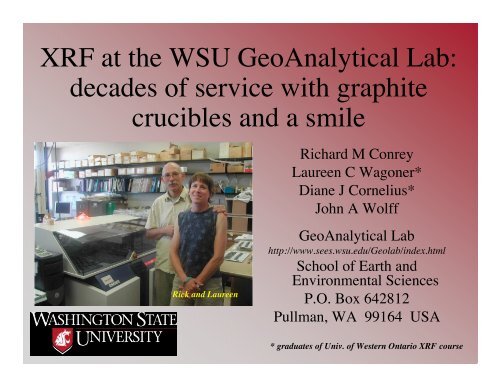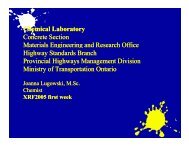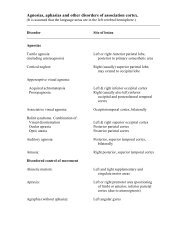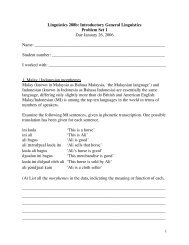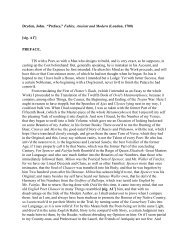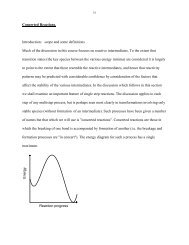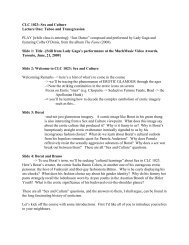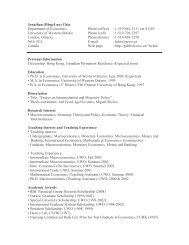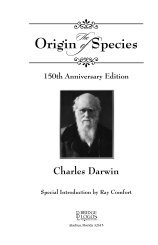XRF at the WSU GeoAnalytical Lab - University of Western Ontario
XRF at the WSU GeoAnalytical Lab - University of Western Ontario
XRF at the WSU GeoAnalytical Lab - University of Western Ontario
You also want an ePaper? Increase the reach of your titles
YUMPU automatically turns print PDFs into web optimized ePapers that Google loves.
<strong>XRF</strong> <strong>at</strong> <strong>the</strong> <strong>WSU</strong> <strong>GeoAnalytical</strong> <strong>Lab</strong>:<br />
decades <strong>of</strong> service with graphite<br />
crucibles and a smile<br />
Rick and Laureen<br />
Richard M Conrey<br />
Laureen C Wagoner*<br />
Diane J Cornelius*<br />
John A Wolff<br />
<strong>GeoAnalytical</strong> <strong>Lab</strong><br />
http://www.sees.wsu.edu/Geolab/index.html<br />
School <strong>of</strong> Earth and<br />
Environmental Sciences<br />
P.O. Box 642812<br />
Pullman, WA 99164 USA<br />
* gradu<strong>at</strong>es <strong>of</strong> Univ. <strong>of</strong> <strong>Western</strong> <strong>Ontario</strong> <strong>XRF</strong> course
Mission <strong>of</strong> <strong>the</strong> <strong>XRF</strong> portion <strong>of</strong> our lab<br />
Since our founding circa 1973 by Peter Hooper we have served thousands <strong>of</strong><br />
researchers with X-Ray Fluorescence d<strong>at</strong>a<br />
Our client base is chiefly o<strong>the</strong>r universities around <strong>the</strong> USA and <strong>the</strong> world, our own<br />
students and faculty, and government agencies both local and federal<br />
We strive to provide research quality d<strong>at</strong>a <strong>at</strong> an affordable price and to educ<strong>at</strong>e both<br />
our students and visitors in <strong>the</strong> methods <strong>of</strong> sample prepar<strong>at</strong>ion and X-Ray<br />
Fluorescence analysis<br />
A gradu<strong>at</strong>e level X-Ray Analysis course has been taught <strong>at</strong> <strong>WSU</strong> by Nick Foit for<br />
three decades, with a focus on XRD, <strong>XRF</strong> and electron microprobe analysis<br />
Diane<br />
Our lab also houses a JEOL 8500F field emission electron microprobe, Siemens D-500 powder X-ray<br />
diffractometer, Agilent 7700 ICP-MS, Thermo-Finnegan Neptune multi-collector ICP-MS, Thermo-Finnegan<br />
Element2 high precision ICP-MS, Finnegan Delta S gas source mass spectrometer, and a Perkin-Elmer<br />
Spectrum GX FTIR<br />
Nick<br />
John <strong>at</strong> <strong>the</strong> JEOL console
<strong>XRF</strong> <strong>at</strong> <strong>WSU</strong> - a brief history<br />
� ~1973: <strong>XRF</strong> lab started by Peter<br />
Hooper and his gradu<strong>at</strong>e students<br />
working on <strong>the</strong> Columbia River basalts<br />
� Peter adopted <strong>the</strong> low dilution fusion<br />
in graphite method to measure both<br />
major and trace elements based upon<br />
his prior experience in Wales<br />
� ~1976: first <strong>XRF</strong>: a “biologically<br />
autom<strong>at</strong>ed” Philips PW1410<br />
� 1980s: radioactive waste project <strong>at</strong><br />
Hanford provides steady work<br />
� 1986: autom<strong>at</strong>ed Rigaku 3370 <strong>XRF</strong><br />
� 1984 - 2009: <strong>the</strong> <strong>XRF</strong> lab blossoms<br />
under Diane Johnson Cornelius<br />
� 1997: Peter retires, John Wolff<br />
assumes directorship <strong>of</strong> <strong>the</strong> GAL<br />
� 2004: Thermo-ARL Advant’XP+<br />
<strong>XRF</strong> spectrometer installed<br />
� 2010: <strong>XRF</strong> lab now run by Rick<br />
Conrey and Laureen Wagoner, both<br />
former students <strong>of</strong> Peter Hooper<br />
7000<br />
6000<br />
5000<br />
4000<br />
3000<br />
2000<br />
1000<br />
0<br />
Steve<br />
Reidel<br />
<strong>XRF</strong>, ICP-MS samples/year through 2009<br />
<strong>XRF</strong><br />
ICP-MS<br />
1988 1990 1992 1994 1996 1998 2000 2002 2004 2006 2008<br />
Peter<br />
Hooper<br />
Vic<br />
Camp<br />
Marty<br />
Ross
Graphite has many advantages<br />
� Ease <strong>of</strong> maintenance, fabric<strong>at</strong>ion,<br />
and cleaning, inert, inexpensive,<br />
efficient, rare to make unusable<br />
pellet, no releasing agent required<br />
� Allows single recipe with Litetrabor<strong>at</strong>e<br />
for nearly all samples -<br />
we analyze nearly all rock types,<br />
minerals and soils with <strong>the</strong><br />
exception <strong>of</strong> ores - little need* to<br />
know beforehand wh<strong>at</strong> you are<br />
analyzing<br />
� Allows low dilution str<strong>at</strong>egy - traces<br />
measured on same pellet as majors;<br />
full m<strong>at</strong>rix correction for all<br />
elements<br />
� * Mg-, Fe-, Ca-, P, or Mn-rich<br />
samples can be diluted with pure<br />
fused silica to ensure good glass<br />
form<strong>at</strong>ion upon cooling<br />
Life <strong>of</strong> a graphite crucible<br />
<strong>XRF</strong> ICP<br />
custom boring tool<br />
~ 60 fusions/crucible<br />
• Graphite crucible cost - $US 8<br />
• machined in-house from ultra-pure rod<br />
• nearly all <strong>WSU</strong> ICP-MS analyses begin<br />
with a graphite fusion<br />
24 fusions possible<br />
every 45 minutes
Graphite doubly fused beads - glass with some carbon on top<br />
graphite crucible loading<br />
Kimwipe +<br />
compressed air<br />
cleaning<br />
� homogeneity requires re-grind (30 sec/bead) and<br />
re-fusion <strong>of</strong> graphite st<strong>at</strong>ic fused beads<br />
� loss <strong>of</strong> powder is imm<strong>at</strong>erial <strong>at</strong> re-grind stage<br />
� buffing reduces carbon load before re-grind<br />
powders are weighed into<br />
plastic jars, mixed with a<br />
Vortex mixer, and passed<br />
over an anti-st<strong>at</strong>ic bar<br />
prior to loading<br />
Graphite fusions<br />
re-grinding
� diamond grinding in w<strong>at</strong>er is fast (total 2-3 min/bead)<br />
� final cleaning in sonic<strong>at</strong>or with ethanol<br />
� lapping removes diffusion pr<strong>of</strong>ile <strong>at</strong> contact <strong>of</strong> glass and crucible - final surface finish is 15 microns<br />
29 mm 15 mm 8 mm<br />
Mask Sample wt Minimum wt<br />
29 mm 3.5 gm 1.5 gm<br />
15 mm 1.1 gm 0.5(?) gm<br />
8 mm 0.4 gm 0.2(?) gm<br />
Sizing/lapping <strong>of</strong> graphite fused beads<br />
machined templ<strong>at</strong>e assures accur<strong>at</strong>e sizing<br />
We calibr<strong>at</strong>e with smaller masks for beads down to 8 mm diameter<br />
Not simply a reduction in counts across <strong>the</strong> spectrum - varies with 2<strong>the</strong>ta<br />
because <strong>of</strong> crystal geometry so many parameters change<br />
Precision varies as square root <strong>of</strong> counts so degraded by factor ~2 each<br />
step down in size - we count twice as long <strong>at</strong> 15 mm and 4x <strong>at</strong> 8 mm<br />
Small sample analyses<br />
1600<br />
1400<br />
1200<br />
1000<br />
800<br />
600<br />
400<br />
200<br />
0<br />
Concentr<strong>at</strong>ion (ppm)<br />
vs. m<strong>at</strong>rix corrected<br />
intensity (kcps)<br />
Zr calibr<strong>at</strong>ion <strong>at</strong> 8 mm<br />
SEE = 4.2 ppm; n =14<br />
r 2 = 0.9999<br />
0 0.2 0.4 0.6 0.8 1
50 ton anvil press<br />
“mini”-chipper<br />
(sub-2 mm)<br />
Breaking and chipping, splitting and grinding<br />
<strong>the</strong> Cadillac <strong>of</strong> splitters<br />
It’s important not to<br />
contamin<strong>at</strong>e during<br />
chipping - need a<br />
very hard surface<br />
Our custom-made<br />
(<strong>WSU</strong> Tech Services)<br />
chipmunks use<br />
hardened tool steel<br />
pl<strong>at</strong>es - we’re still<br />
using <strong>the</strong> original<br />
35+ yr old pl<strong>at</strong>es<br />
Rocklabs ring mill<br />
Random sub-sampling <strong>of</strong> rocks is critical: we mini-chip coarse samples and reduce<br />
splitting error to <strong>the</strong> level <strong>of</strong> analytical error with a Rocklabs rotary splitter<br />
Coarse<br />
chipmunk<br />
Retsch planetary ball mill<br />
We normally grind in Ta-free Rocklabs WC (< 120 g) for both <strong>XRF</strong> and ICP-MS or<br />
in ag<strong>at</strong>e (< 20 g) on request or for soils; small ball mills are used for < 3 g samples WC and ag<strong>at</strong>e ball mills
1<br />
0.9<br />
0.8<br />
0.7<br />
0.6<br />
0.5<br />
0.4<br />
0.3<br />
0.2<br />
0.1<br />
0<br />
The nitty gritty <strong>of</strong> a <strong>WSU</strong> <strong>GeoAnalytical</strong> <strong>Lab</strong> <strong>XRF</strong> analysis<br />
� collect intensities <strong>at</strong> 36 peak and 25 background positions (~ 66 min/sample) for all samples<br />
� calcul<strong>at</strong>e net peak minus background intensity for each element (<strong>of</strong>ten require linear and even<br />
parabolic* m<strong>at</strong>rix-dependent background slope correction)<br />
� correct <strong>the</strong> net intensities for 135 spectral interferences (pk on pk, pk on bgd, Compton tails)<br />
� calcul<strong>at</strong>e raw concentr<strong>at</strong>ions from corrected intensities using <strong>the</strong> calibr<strong>at</strong>ion curves (set with 75 to 105<br />
highly diverse CRMs)<br />
� calcul<strong>at</strong>e m<strong>at</strong>rix corrected concentr<strong>at</strong>ions from <strong>the</strong> raw concentr<strong>at</strong>ions by iter<strong>at</strong>ion using <strong>the</strong><br />
fundamental parameters method (with <strong>the</strong> absorbance values <strong>of</strong> <strong>the</strong> NIST-GSC using Al, Ba, Ca, Cl, Cr,<br />
Fe, K, Mg, Mn, Na, P, S, Si, Sr, Ti, Zr and estim<strong>at</strong>ed LOF as m<strong>at</strong>rix elements)<br />
� recalcul<strong>at</strong>e <strong>the</strong> corrected concentr<strong>at</strong>ions by iter<strong>at</strong>ion using an estim<strong>at</strong>ed loss on fusion (LOF; simply 100<br />
minus <strong>the</strong> analytical sum) to correct for raw powder** analysis and vol<strong>at</strong>ile loss <strong>of</strong> weighed rock powder<br />
upon fusion (correction for not truly 2:1 flux:rock mixture)<br />
** raw powder is much preferred due to potential sample damage and partial analyte losses (chiefly <strong>of</strong> Pb, K, and Rb) during<br />
ignition loss measurements, especially for halide-rich samples<br />
* parabolic background<br />
correction for Zr<br />
Zr peak minus<br />
background vs.<br />
RhKb Compton<br />
intensity<br />
y = 0.00003424x 2 + 0.00485338x + 0.07247217<br />
R 2 = 0.99536438<br />
mixtures <strong>of</strong> silica and<br />
pur<strong>at</strong>ronic compounds<br />
20 40 60 80 100<br />
estim<strong>at</strong>ed loss on<br />
fusion is a robust<br />
approxim<strong>at</strong>ion <strong>of</strong> loss<br />
on ignition - we have<br />
employed this<br />
correction for several<br />
years now on diverse<br />
lithologies. Very Ferich<br />
samples (gray<br />
squares) have high<br />
estim<strong>at</strong>ed LOF due to<br />
reduction <strong>of</strong> Fe +3<br />
Estim<strong>at</strong>ed LOF (wt%)<br />
55<br />
45<br />
35<br />
25<br />
15<br />
5<br />
-5<br />
(A)<br />
y = 0.9972x + 0.9522<br />
R 2 = 0.9891; n = 2552<br />
-5 5 15 25 35 45 55<br />
Measured LOI (wt%)
M<strong>at</strong>rix corrected intensity (kcps)<br />
M<strong>at</strong>rix corrected intensity (kcps)<br />
Major and trace element calibr<strong>at</strong>ion with graphite double fusions<br />
700<br />
600<br />
500<br />
400<br />
300<br />
200<br />
100<br />
0<br />
350<br />
300<br />
250<br />
200<br />
150<br />
100<br />
50<br />
0<br />
K 2O<br />
SEE = 0.044 wt%<br />
R 2 = 0.9998<br />
n = 102<br />
0 4 8 12 16<br />
Al 2O 3<br />
Concentr<strong>at</strong>ion (wt %)<br />
SEE = 0.155 wt%<br />
R 2 = 0.9998<br />
n = 104<br />
0 10 20 30 40 50 60 70 80<br />
Concentr<strong>at</strong>ion (wt %)<br />
M<strong>at</strong>rix corrected intensity (kcps)<br />
M<strong>at</strong>rix corrected intensity (kcps)<br />
0.25<br />
0.2<br />
0.15<br />
0.1<br />
0.05<br />
0<br />
2.25<br />
2<br />
1.75<br />
1.5<br />
1.25<br />
1<br />
0.75<br />
0.5<br />
0.25<br />
0<br />
Sc<br />
Calibr<strong>at</strong>ion requires 5 days <strong>at</strong> ~66 min/CRM but calibr<strong>at</strong>ions hold for 3-10 months<br />
SEE = 0.8 ppm<br />
R 2 = 0.9995<br />
n = 85<br />
0 10 20 30 40 50 60 70 80<br />
V<br />
Concentr<strong>at</strong>ion (ppm)<br />
SEE = 4.9 ppm<br />
R 2 = 0.9987<br />
n = 84<br />
0 100 200 300 400 500 600<br />
Concentr<strong>at</strong>ion (ppm)
Reproducibility <strong>of</strong> major and trace elements using graphite double fusions (n = 850)<br />
Difference from average (wt%)<br />
Difference from average (wt%)<br />
0.015<br />
0.010<br />
0.005<br />
0.000<br />
-0.005<br />
-0.010<br />
-0.015<br />
0.15<br />
0.10<br />
0.05<br />
0.00<br />
-0.05<br />
-0.10<br />
-0.15<br />
P 2O 5<br />
0.0 0.2 0.4 0.6 0.8 1.0 1.2 1.4 1.6<br />
Concentr<strong>at</strong>ion (wt %)<br />
CaO<br />
0 4 8 12 16 20<br />
Concentr<strong>at</strong>ion (wt %)<br />
Difference from average (ppm)<br />
Difference from average (ppm)<br />
8<br />
6<br />
4<br />
2<br />
0<br />
-2<br />
-4<br />
-6<br />
-8<br />
10<br />
8<br />
6<br />
4<br />
2<br />
0<br />
-2<br />
-4<br />
-6<br />
-8<br />
-10<br />
0 20 40 60 80 100<br />
Rb<br />
Nb<br />
Concentr<strong>at</strong>ion (ppm)<br />
0 100 200 300 400 500<br />
Concentr<strong>at</strong>ion (ppm)<br />
Duplic<strong>at</strong>e analyses <strong>of</strong> 850 diverse same sample powders performed over a 5 year period, 2004-2009
<strong>WSU</strong> <strong>XRF</strong> (ppm)<br />
<strong>WSU</strong> <strong>XRF</strong> (ppm)<br />
Graphite fused <strong>XRF</strong> versus graphite fused- acid digested ICP-MS trace elements (n = 1224)<br />
1000<br />
800<br />
600<br />
400<br />
200<br />
200<br />
160<br />
120<br />
80<br />
40<br />
0<br />
0<br />
Ba<br />
y = 0.9827x + 5.763<br />
R 2 = 0.9995<br />
0 200 400 600 800 1000<br />
Ce<br />
<strong>WSU</strong> ICP-MS (ppm)<br />
y = 0.9908x - 0.6172<br />
R 2 = 0.9985<br />
0 40 80 120 160 200<br />
<strong>WSU</strong> ICP-MS (ppm)<br />
<strong>WSU</strong> <strong>XRF</strong> (ppm)<br />
<strong>WSU</strong> <strong>XRF</strong> (ppm)<br />
200<br />
160<br />
120<br />
80<br />
60<br />
40<br />
20<br />
80<br />
40<br />
0<br />
0<br />
Y<br />
y = 0.9715x + 0.6721<br />
R 2 = 0.9988<br />
0 40 80 120 160 200<br />
Th<br />
<strong>WSU</strong> ICP-MS (ppm)<br />
y = 0.9885x + 0.5574<br />
R 2 = 0.9906<br />
0 20 40 60 80<br />
<strong>WSU</strong> ICP-MS (ppm)<br />
All 1224 analyses performed over an eight month period in 2009 on a single <strong>XRF</strong> calibr<strong>at</strong>ion
Summary<br />
� Our lab has served a broad Earth science research clientele over <strong>the</strong><br />
past 35 years using low dilution graphite fusions for <strong>XRF</strong> analysis<br />
� Graphite provides more than sufficient reproducibility for <strong>the</strong> vast<br />
majority <strong>of</strong> bulk rock analyses (our lab is <strong>of</strong>ten chosen for certific<strong>at</strong>ion<br />
studies due to our consistent performance on GeoPT samples)<br />
� Graphite allows employment <strong>of</strong> a robust low dilution fusion str<strong>at</strong>egy<br />
for nearly all geologic m<strong>at</strong>erials save ores<br />
� We thank Charles Wu and <strong>the</strong> instructors <strong>of</strong> <strong>the</strong> <strong>University</strong> <strong>of</strong> <strong>Western</strong><br />
<strong>Ontario</strong> <strong>XRF</strong> course for <strong>the</strong>ir excellence in instruction and in prepar<strong>at</strong>ion<br />
<strong>of</strong> course m<strong>at</strong>erials. The UWO courses have deepened <strong>the</strong> knowledge<br />
base <strong>of</strong> our technical staff and helped us fur<strong>the</strong>r our goals <strong>of</strong> providing<br />
educ<strong>at</strong>ion and good d<strong>at</strong>a <strong>at</strong> a reasonable cost.


